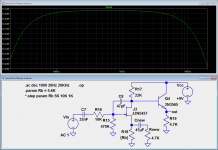Chuck D. Bones
Circuit Wizard
Anyone know anything about this other than what Reverb says?

The input and output impedances of this circuit are flipped as compared to modern practices. This creates a few problems, but it also causes that amazing clean tone you can get when rolling back your guitar's volume knob. However try placing it after a buffer or a wah. No thank you.
Fjord Fuzz to the rescue! Many have used the very cool AMZ pickup simulator trick to solve this and while this does kind of work, it also adds a bunch of noise and definitely impacts the volume knob cleanup. The rightmost push button on BERSERK engages a simple, weirdly biased, single transistor gain stage preamp in front of the original circuit.
Gone are the wah and buffer issues, but does it still clean up? Does it still allow you to get that super sticky, thick, asymmetric clipping? YES! It's almost indistinguishable from the original preampless circuit, with none of the problems. Doesn't this turn it into more of a MK2 style fuzz though? Yes and no. Topologically speaking it definitely does, and by dialling back the thickness knob you can get into the MK2 territory, but the intention here was to retain all the tonal characteristics of the smiley pedal and I did.
There's a trimmer on the inside to help you match this feature with you specific use case. If you don’t intend to stick this pedal after a wah or a buffer or whatever, you can also use the trimmer to increase gain and chase down that MK2 route even further if that's more your speed!
[...]
BERSERK is biased to 6.66V which is how most of my pedals are biased, but you can change that if you want. Go for 3V for that Johnson farty boy tone or 4.5-5V for a more vintage correct fuzz tone, if there is such a thing. The PCB is clearly marked with instructions on how to do this!
What about ditching R14 and R13, using a 27K for R17 and a 5K trimmer for R18 with the wiper going to R15 for biasing?Here's the Roland Space Echo Preamp, right outta the service manual. It runs at 15V, would need some resistor value tweaks to bias correctly with +9V. Q3 & Q4 can be any of the usual suspects, we just tweak R13 or R14 to get Q4-E around 1/2 Vcc. Gain is approx 15dB.
View attachment 16688

I was just looking for this amongst the plethora of PCBs on PedalPCB — it needs to be added to the wish list (the CDB's modded version of course!)Here's the Roland Space Echo Preamp, right outta the service manual. It runs at 15V, would need some resistor value tweaks to bias correctly with +9V. Q3 & Q4 can be any of the usual suspects, we just tweak R13 or R14 to get Q4-E around 1/2 Vcc. Gain is approx 15dB.
View attachment 16688
Definitely needs an output cap and a Level control. If the Level control is 50K or larger, then 100nF would be good. Rnew could be a C5K pot to vary the gain.I was just looking for this amongst the plethora of PCBs on PedalPCB — it needs to be added to the wish list (the CDB's modded version of course!)
AKA — a modded Nocturne Brain Seltzer, or whatever Tavi is calling it now.
PS: Would it be good to add an output cap to your modded circuit, say 100n?
Here's the Roland Space Echo Preamp, right outta the service manual. It runs at 15V, would need some resistor value tweaks to bias correctly with +9V. Q3 & Q4 can be any of the usual suspects, we just tweak R13 or R14 to get Q4-E around 1/2 Vcc. Gain is approx 15dB.
I like the fuzz face quite a bit, and I can see room for improvement or tweaking for personal preference with particular rigsThe whole input and output stage around a Fuzz Face reminds me of a rabbit hole I went down a year or two ago. I breadboarded a bunch of different ideas, trying to make something different (I know, something different with the Fuzz Face *eye roll*)
One thing I remember was an op-amp buffer in front and I tried different active tone controls after, including a Baxandall and a Klon treble control, which was actually pretty sweet as I recall. Some series resistance (10k - 100k) between the buffer and the Fuzz Face helped get rid of some of the harshness and noise. I don't remember how the clean-up was, as I never cared much for that feature in the first place.
The hardest part was biasing, so I would often go for external bias controls and I liked the textural changes this allowed for. I ultimately abandoning the Fuzz Face entirely in favor of finding something less sensitive to bias and other external factors like impedance and temperature. I also felt dissatisfied about presenting YAFF to the world if I wanted to publish or commercialize my hobby.
I never boxed any of these up, but I drew up everything I found even remotely interesting. Maybe a schematic dump is in order when I get my work area back together...
What value and taper do you use, please sir?I like to put a pot in series with the FF's input so I can vary the FF's input impedance.
